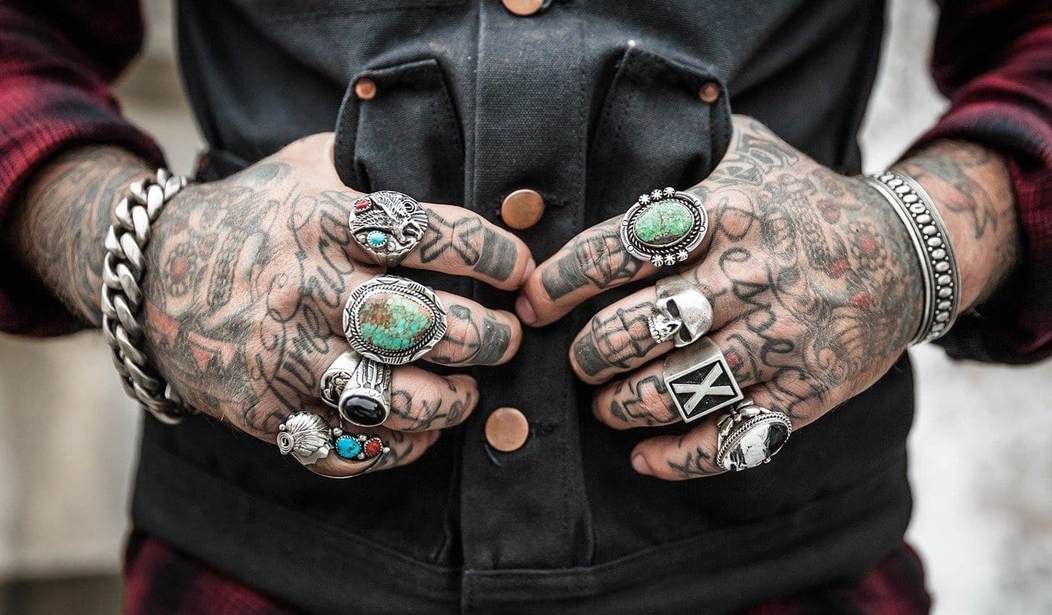Tattoos are not new. What is new is their ubiquity and extent of body coverage. They meet the eye with livid starkness everywhere one looks, turning the atmosphere and the culture positively fluorescent. What was once a niche market has expanded exponentially. Practically everyone of a certain age group, say, late teens to early fifties, seems to flaunt these decorative glyphs and totems on every visible part of their bodies, including the head and face. (Actress Amanda Bynes and rapper Post Malone are recent celebrity examples.) And judging from my experience in the change room of the gym where I work out, these chromatic blemishes, particle illustrations of a much wider significance, appear on the less visible parts of a person’s anatomy as well.
It’s a phenomenon that continues to puzzle me. Every era, of course, is marked by its own fashion anomalies once considered normative or appealing, which we often tend to regard as quaint, ridiculous, garish or merely amusing—to take just one example, the dandyism of red waistcoats, green wigs and blue hair in 19th-century Paris. Today is no exception, though we need not look back to find them absurd or grotesque. How one can appraise sumptuary excesses like the fade cut, pink hair, septum rings, tongue studs, navel piercings, and the prevalence of the orgulous tattoo as in any way attractive boggles the mind.
As the World Journal of Psychiatry points out in a methodological case study focusing on statistical distributions and issues relating to epidemiology, tattoos were traditionally associated with deviance and psychopathology, typically criminals, gang members and “others belonging to marginalized and counter-cultural groups.” (One recalls those Grade B gangster films featuring Russian mafia members, their arms, backs and chests slathered with lurid insignia rankings.) The tattoo serves “to align the wearer with a specific group,” offering comfort, protection and a collective identity. Tattoos are often also used as a kind of rebus meant to “bolster low self-esteem” or “repair a crippled self-image.”
Some analysts believe that tattoos serve an ultimate evolutionary purpose rooted in sexual selection. The “human canvas” theory postulates that tattooing is an expression of human culture and “symbolic thought,” with skin art developed “as a means to illustrate one’s personal story.” The “upping the ante” theory “suggests that tattoos evolved as a fitness indicator, enhancing one’s appearance in the context of intersexual competition.” In either case, the tattoo was clearly a male emblem inscribed on the flesh of the suitor and intended to interest the female prize, who could read his history and appreciate his vigor.
Starting in the 1980s, tattooing gradually became a mainstream phenomenon as a means of personal expression and as an opportunity “to explore core aspects of self-identity.” The authors of the study isolate five different motivating factors behind the increasingly popular phenomenon: identity-based personal narrative; group solidarity; embellishment of “the body as a fashion accessory”; a “badge that reflects pain tolerance and physical endurance, as a means of emphasizing sexuality [or] as an affiliation with a religious or spiritual tradition”; and an impulse enacted “for no specific reason.” The tattoo is no longer sex-specific, with women flaunting skin art and regarding their bodies as an epidermal canvas almost to the same degree as men—perhaps as another foray into patriarchal territory. Bikers and felons are no longer conspicuous in the mix. Younger people in particular tend to see tats as rendering them sexy or painting them rebellious. But there is more to it than that.
French philosopher Gilles Lipovetsky in The Empire of Fashion: Dressing Modern Democracy argues that standards of dress and self-presentation are assertions of individual autonomy; “the cult of novelty promotes a feeling of independent individuality…becomes a source of discovery, of subjective positioning…a little adventure of the self.” The individual decides to free himself or herself from the tacit rules of tradition. “[O]n the occasion of each shift in fashion,” he continues, “there is a feeling, however tenuous, of subjective freedom, of liberation from past habits.” A new fashion statement is thus an expression of “the individual mastery of the self,” shedding the manacles of the “ancestral legacy.” When not imposed by the totalitarian state as a uniform that erases differences between people, the fashion statement, according to Lipovetsky, becomes a cultural value that finds its “apotheosis in the democratic state,” affirming difference and consecrating the “private personality.”
Yet, the irony is inescapable. As Alexis de Tocqueville wrote in Democracy in America, “in democratic ages even those who are not alike are bent on becoming so and copy each other.” The absolute power of the majority which distinguishes democratic epochs, Tocqueville feared, may have a dampening effect on thought, “thus extinguishing intellectual freedom.” In trying to be different, we all become the same, a herd of individuals sporting the same ideas, the same tastes, the same mullet or fade, the same bell-bottom trousers, the same body piercings, the same ideological fashions, the same fondness for tattoos.
Here, as noted, Lipovetsky takes partial issue with Tocqueville, claiming that the “epidemic of mimesis” still permits people more freedom than times when “religions and traditions attempted to produce a seamless homogeneity of collective beliefs.” Lipovetsky’s thesis is moot; his book was published in 1994, three years after the collapse of the Soviet Union in 1991, and two years after Francis Fukuyama’s The End of History and the Last Man, when the belief in the ascendancy of Western liberal democracy was at its zenith. Now we see that the Soviet Union did not collapse but spread its tentacles into every corner of Western culture, that the ideal of coercive and exclusionary “social justice” has obliterated the principles of merit, competence, honest justice, freedom of speech and intellectual autonomy, and that socialism is once again making a robust comeback. Tocqueville’s warnings would appear to supersede Lipovetsky’s hopes.
What has this to do with the remarkable proliferation of tattoo culture? In one of my more facetious moments I speculated that the tattoo in its current manifestation may be the contemporary equivalent of the Mark of Cain. Genesis 4:15 reads in part: “And the Lord said unto him, Therefore whosoever slayeth Cain, vengeance shall be taken on him sevenfold. And the Lord set a mark upon Cain, lest any finding him should kill him.”
It is not clear precisely what this mysterious mark might have been: a sign, a seal, a brand, an omen, leprosy, an aura, the Tetragrammaton itself. The Kabbalah suggests that the mark may have been a letter of the Hebrew alphabet intended to ward off harm, perhaps the letter vav [ו], the binding token, the divine ampersand. If there is a subliminal recognition or underlying fear pervading the culture that we are at risk, that the values on which the life of the West is predicated are rapidly deteriorating, that we inhabit an era of social and economic insecurity, then perhaps we are unconsciously seeking some means of protection from the threats that surround us. The tattoo that “marks” both individual uniqueness and group solidarity becomes a sign of our salvation.
This is obviously a fanciful conjecture—and yet the problem remains of how to account for so unprecedented a pandemic of pictograms, ink splotches, gothic images, names, letterings, theriomorphic images, esoteric icons and various indescribable maculations inscribed on foreheads, limbs, torsos and more discreet parts. I think of the mad painter Frenhofer in Honoré de Balzac’s Le Chef d’oeuvre inconnu (The Unknown Masterpiece), who believes he is depicting something beautiful but whose canvas is an unintelligible swirl of florid pigments and tangled arabesques.
Ray Wronsov in The Mark of Cain: The Aesthetic Superiority of the Fashionable takes a fascist view of the extravagances of fashion, treating the Mark of Cain as something like the Mark of the Beast in Revelations, but in this case a laudable banner under which the bearers of beauty, strength and originality “exclude and torment the unworthy.” Wronsov would regard the omnipresent tattoo as a symbol of the powerful and elect determined to set themselves off from the commonplace and ultimately to eliminate those considered weak, ugly and ordinary. His theory is also a fanciful notion but, in its less bloodthirsty manifestation, would imply that the tattoo is the sign of the new patriciate, the cultural elite, the beau monde—quite literally, the glitterati who embody Lipovetsky’s consummate ethos of aristocratic privilege.
By all accounts tattoos are not a benign phenomenon. They can expose their bearers to HIV/AIDS and Hepatitis C. Tattoos can affect the way a body sweats, causing loss of electrolytes. They accentuate the risk of infection and enhance the possibility of melanoma. Pregnancy and weight gain can lead to tattoo distortion. As plastic surgeon Cormac Joyce writes, tattooing “involves the integration of metallic salts and organic dyes into the dermal layer of the skin,” which may produce “malignant transformation.” Justin Caba in Medical Daily notes the rise of what is called “tattoo regret” and “tattoo remorse,” especially in light of its difficulty of removal and sometimes permanence. As people grow older or gain in maturity, they may come to realize the indignity and indeed deformity associated with the tattoo.
Nonetheless, the tattoo persists as a sign of the times. It is not merely a moderately popular eccentricity or cutaneous affectation, which in itself or as a single instance need not be offensive. But in whatever way its extraordinary prominence and body coverage may be interpreted, it strikes me as a massively tribal phenomenon involving the carpeting of the body on the assumption that such overlays function as a species of armor or a web of apotropaic patterns—that is, signs intended to parry or deflect evil influences—or a narrative of the self graven in a visible medium. Such figures or devices may come to the fore when a culture senses the loss of authentic identity or begins to suspect it has no right to exist, that it is subject to the curse of erasure. They represent an attempt to impose meaning in a worried recognition that meaning has gone out of the culture. We live in a time of dark intuitions, a time of endings, in which the integrated and substantial self is eroding under the corrosive effect of the loss of historical confidence, of gender fluidity, runaway multiculturalism, political correctness, vast educational deficits and the rise of collectivist ideology. Like Cain, we are under threat for our complicity in an act of violence—call it cultural homicide.
In such times a generation may strive to mark itself as singular and separate, as an assembly of heroic individuals reminiscent of Nietzsche’s Übermensch rising above the “last man” of a dying culture—fighting the recognition that they are themselves these “last men.” They see themselves as the initiates of the future, as special cases, as different from the common ruck, as “marked out,” as deserving of redemption, as unique and distinctive. Unfortunately, it is a generation that has little to distinguish itself apart from the external excrescences of bark art, signalling an unmerited estimation of the self. Such ostensible badges of uniqueness are really emblems of desperation and one-dimensional effigies of mundane sameness, in effect, disfigurements that betoken an inner suspicion of weakness and vulnerability, and of the need for protection.
What a tale a tattoo tells! Admittedly, my reading of a cultural contagion is merely a rarefied hypothesis, yet it may enjoy a degree of plausibility. It may be argued that in the absence of spiritual depth and intellectual substance, these stamped epitomes of a culture in extremis seek to establish an epidermal identity as the only psychic option remaining to them. In a time of historical amnesia and hedonistic excess, they call attention to themselves in the only way they know how—through an emblazoned superficiality. Perhaps they may be saved. They bear the Mark.
———————————
David Solway’s latest book is Notes from a Derelict Culture, Black House Publishing, 2019, London. A CD of his original songs, Partial to Cain, appeared in 2019.










Join the conversation as a VIP Member